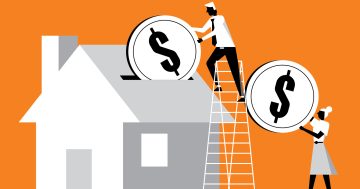Stephen Kirchner* says the false narratives around the failure of Lehman Brothers and its role in the Global Financial Crisis may have done as much harm as the failure itself.
 The failure of Lehman Brothers on 15 September 2008 has become synonymous with the crisis that engulfed the US and European financial systems a decade ago, but left Australia’s banks relatively unscathed.
The failure of Lehman Brothers on 15 September 2008 has become synonymous with the crisis that engulfed the US and European financial systems a decade ago, but left Australia’s banks relatively unscathed.
Yet the ghost of Lehman still looms large for regulators, even in Australia, and was an important influence on the thinking of the 2014 Murray Financial System Inquiry.
Many talk about Lehman as though its failure single-handedly caused the crisis.
Yet the “Lehman moment” was more symptom than cause.
Anton Valukas, the examiner in Lehman’s bankruptcy proceedings, concluded that “Lehman was more the consequence than the cause of a deteriorating economic climate”.
While the S&P 500 stock index fell dramatically on 15 September, it was up again the next day and rallied later in the week to post a higher close on 19 September than on either the 12th or the 15th.
It was only after US Federal Reserve Chairman, Ben Bernanke and US Treasury Secretary, Hank Paulson made speeches on 23 September and 24 September predicting dire consequences if Congress failed to pass a discretionary bailout bill, and Congress failed to oblige, that the stock market tanked.
As John Cochrane later observed, “the President gets on television and says the financial markets are near collapse”.
“On what planet do markets not crash after that?”
Fed was too slow to respond to market downturn
Far more serious than the failure of Lehman was the slow response of the US Federal Reserve to the downturn in the US economy that began in December 2007.
The Federal Open Market Committee met the day after Lehman’s failure and left the Federal funds rate unchanged at 2 per cent.
The Committee expressed concern about upside inflation risks even as inflation expectations implied by US Treasuries were collapsing before them.
It was not until 16 December that the Fed funds rate was lowered to near zero and the first episode of quantitative easing (QE) began.
Even then, the Fed’s initial asset purchases were fully sterilised because of its misplaced fear that extra liquidity might stoke inflation.
With $1 trillion in creditor claims, Lehman was the biggest and most complex bankruptcy in US history.
But no other financial institution or derivatives counterparty failed as a direct or even indirect result of Lehman.
The bankruptcy code was perfectly adequate for resolving its failure.
Mr Bernanke has said the failure to rescue Lehman was a mistake, but policymakers’ hands were tied by legal constraints.
As Larry Ball argues, this claim is almost certainly wrong in a legal sense.
Under political pressure not to put more taxpayer funds at risk in another bailout, the Fed failed to follow Walter Bagehot’s classic dictum in relation to the lender of last resort function of central banks: “Lend freely, at a penalty rate, against good collateral.”
But would the Global Financial Crisis have been less severe had Lehman been rescued?
By itself, it would have done little to alleviate problems elsewhere in the financial system.
Even if a rescue had calmed financial markets, the Fed would likely have been even slower to respond to the downturn in the economy.
Failure was trivial compared with earlier events
The failure of Lehman Brothers was a trivial event compared with the much bigger but largely ignored failure that took place one week before, when two Government-sponsored enterprises (GSEs), Freddie Mac and Fannie Mae, were put into “conservatorship” by the US Government.
The two highly leveraged and undercapitalised mortgage giants were responsible for one of the world’s largest fixed-income markets, with outstandings of $8.1 trillion by one estimate.
By comparison, the US Government then owed $7.8 trillion, while all non-financial US corporations owed $7.1 trillion.
The Fed’s subsequent purchases of GSE debt single-handedly doubled the size of its balance sheet.
The GSEs had been mandated by Congress to promote homeownership, but would ultimately see the US homeownership rate fall to a 50-year low of 62.9 per cent in 2016.
The GSEs were public policy and financial disasters that easily dwarfed Lehman.
In the years since, the false narrative of the “Lehman moment” has heavily influenced public policy.
Charles Goodhart told the Reserve Bank of Australia’s fiftieth anniversary conference in 2010 that the Lehman failure was “so awful that in virtually every major economy the authorities have effectively taken a vow that they will not allow any similar really large, interconnected systemic institution to be closed”.
Regulatory responses to the crisis have now institutionalised the notion of “too big to fail”.
Derivatives regulation has dangerously socialised and concentrated counterparty default risk into clearing houses, making them less robust to failure.
The GSEs have so far escaped reform.
Gun-shy central banks continue to undershoot their inflation mandates.
The false narratives about the causes and consequences of Lehman’s failure have probably done as much harm as the failure itself.
* Dr Stephen Kirchner is Program Director, Trade and Investment, in the US Studies Centre at the University of Sydney.
This article first appeared at www.abc.net.au.







